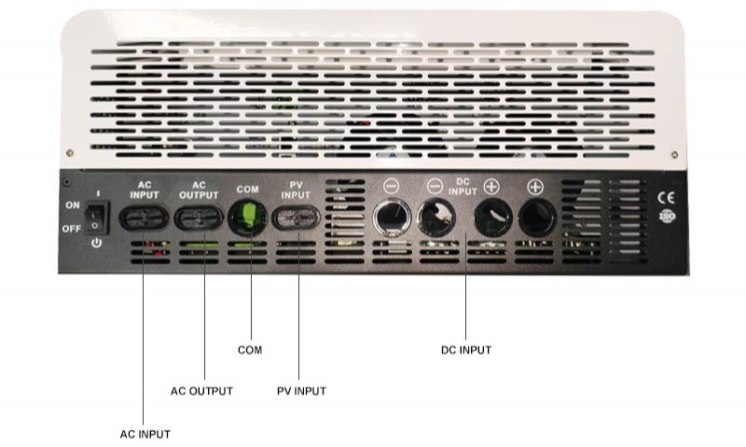What is a low frequency solar inverter ?
Aug 24, 2023
In a solar photovoltaic system, the inverter plays a vital role. It is responsible for converting the direct current (DC) generated by the photovoltaic panels into alternating current (AC) for home and commercial use. According to their operating frequencies, inverters are mainly divided into high-frequency inverters and low-frequency inverters. This article will introduce the characteristics, advantages and applicable scenarios of low-frequency solar inverters in detail from the professional perspective of GreenMore.
1. Working principle of low frequency solar inverter
Low-frequency solar inverters use power frequency transformers to convert direct current (DC) to alternating current (AC), and their core operating frequency is 50Hz or 60Hz. Compared with high-frequency inverters, low-frequency solutions use the principle of electromagnetic induction to achieve voltage amplitude adjustment and electrical isolation through transformer windings. This design retains the stability advantage of traditional power frequency transformers, while reducing harmonic interference by optimizing the filter circuit, and the output waveform is closer to a standard sine wave.
At the structural level, low-frequency inverters usually include DC input, full-bridge inverter circuit, power frequency transformer, filter circuit and control module. Among them, the power frequency transformer, as a key component, undertakes the dual functions of voltage conversion and safety isolation. Its core material is made of high-permeability silicon steel sheets to effectively reduce hysteresis loss and eddy current loss.
Key features of low frequency inverter:
High power output: Low frequency inverters are able to handle higher power loads due to the use of conventional oversized transformers.
Better shock resistance: suitable for starting equipment that requires instantaneous high power, such as motors, refrigerators, etc.
More stable performance: It has stronger adaptability to power grid fluctuations, especially excellent performance in harsh environments.
2. Advantages of Low Frequency Solar Inverter
High reliability and long life
Because their design is based on mature power frequency technology, low-frequency inverters have high mechanical strength and electrical stability. This enables them to maintain efficient operation for a long time and reduce maintenance requirements.
Excellent overload capability and peak power support
Low-frequency inverters can withstand overload conditions for a longer period of time and provide strong peak power support, which is especially important for starting high-power electrical appliances.
Better thermal management
Compared with high-frequency inverters, low-frequency inverters can maintain good working conditions under high temperature conditions because they use a larger heat dissipation area and a more effective cooling mechanism.
3. Application scenario analysis
Home energy storage system
For households with many home appliances, choosing a reliable low-frequency inverter can ensure stable power supply even during peak power demand periods. For example, the low-frequency inverter provided by GreenMore’s home energy storage system can not only effectively manage daily power consumption, but also provide continuous backup power in emergencies.
Commercial and industrial use
In commercial buildings or factory environments, power demand is often greater and more diverse. Low-frequency inverters are one of the ideal solutions due to their excellent overload capacity and stability. The low-frequency inverters equipped in GreenMore commercial battery energy storage cabinets can meet various complex power needs, helping users achieve energy cost savings and green transformation.
Remote areas far from the city power grid
In these places, the power supply is unstable or there is a lack of grid access. The powerful functions of low-frequency inverters make them the first choice for independent solar power generation systems to ensure the basic living electricity of local residents.
4. How to choose a suitable low-frequency solar inverter?
GreenMore recommends users to make comprehensive decisions based on load characteristics, environmental conditions and cost budget:
Scenarios requiring high reliability: Prioritize low-frequency solutions with an MTBF (mean time between failures) greater than 100,000 hours and a maintenance cycle extended to 5 years.
Space-constrained scenarios: Consider a combination of a high-frequency inverter and a GreenMore wall-mounted energy storage battery, which reduces the volume by 60% and the weight by 45%.
Smart grid requirements: GreenMore provides low-frequency inverters that support the IEC 61850 protocol and can be connected to the energy management system (EMS) to achieve power prediction and remote operation and maintenance.
With the rapid development of the renewable energy market, it is becoming increasingly important to understand the functional characteristics of different types of inverters. Low-frequency solar inverters, with their unique advantages, play an irreplaceable role in specific application scenarios. Whether it is to increase household energy self-sufficiency or to promote enterprises towards sustainable development, GreenMore is committed to providing customers with the highest quality low-frequency solar inverters and related services to help build a more environmentally friendly and efficient future energy system.



 Network Supported
Network Supported